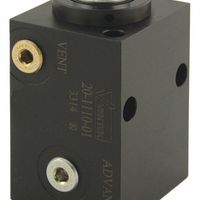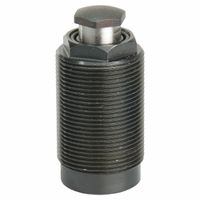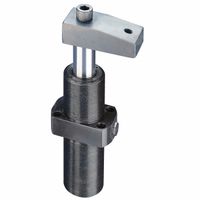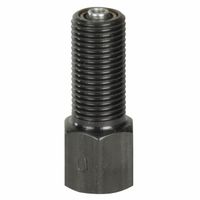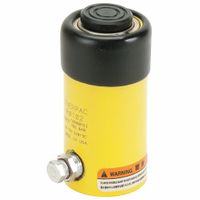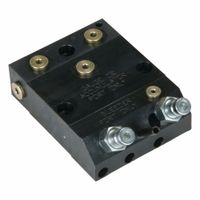Call +(254) 703 030 000 / 751 483 999 / 721 704 777
- Home
- Hydraulics
- Hydraulic Cylinders Seals
- Workholding Hydraulic Cylinders
.....Read More
Frequently Asked Questions
What are the benefits of using hydraulic cylinders in workholding applications?
Hydraulic cylinders offer several benefits in workholding applications:
1. **High Force Output**: Hydraulic cylinders can generate substantial force, making them ideal for securing heavy or large workpieces with precision and stability.
2. **Consistent Clamping Pressure**: They provide uniform clamping pressure, ensuring consistent and repeatable workholding, which is crucial for maintaining quality in manufacturing processes.
3. **Compact Design**: Despite their high force output, hydraulic cylinders are compact, allowing them to be integrated into tight spaces within machinery or fixtures.
4. **Versatility**: They can be used in a variety of configurations and applications, including clamping, lifting, and positioning, making them highly versatile.
5. **Smooth Operation**: Hydraulic systems offer smooth and controlled movement, reducing the risk of damaging workpieces during clamping or unclamping.
6. **Adjustability**: The pressure and speed of hydraulic cylinders can be easily adjusted, providing flexibility to accommodate different workpiece sizes and materials.
7. **Durability and Reliability**: Built to withstand harsh industrial environments, hydraulic cylinders are durable and require minimal maintenance, ensuring long-term reliability.
8. **Automation Compatibility**: They can be easily integrated into automated systems, enhancing productivity and reducing the need for manual intervention.
9. **Energy Efficiency**: Hydraulic systems can be energy-efficient, as they only consume power when the system is in operation, reducing overall energy costs.
10. **Safety**: Hydraulic cylinders can be equipped with safety features such as pressure relief valves, ensuring safe operation and preventing overloading.
These benefits make hydraulic cylinders a preferred choice in workholding applications across various industries, including automotive, aerospace, and manufacturing.
How do swing-clamp hydraulic cylinders function in automated systems?
Swing-clamp hydraulic cylinders function in automated systems by combining linear and rotary motion to secure and release workpieces efficiently. These cylinders consist of a piston and rod assembly within a cylindrical housing, powered by hydraulic fluid. When hydraulic pressure is applied, the piston moves linearly, extending the rod. The rod is attached to a clamp arm, which is designed to rotate as it extends or retracts.
The operation begins with the hydraulic fluid entering the cylinder, pushing the piston forward. This linear motion is converted into rotary motion through a helical groove or cam mechanism, causing the clamp arm to swing into position over the workpiece. Once the arm is in place, the cylinder continues to extend, applying downward force to secure the workpiece firmly.
To release the workpiece, the hydraulic pressure is reversed, retracting the piston. As the piston retracts, the clamp arm swings back to its original position, freeing the workpiece. This dual-action motion allows for quick and precise clamping and unclamping, essential for high-speed automated systems.
Swing-clamp hydraulic cylinders are integral in manufacturing and assembly lines, where they provide consistent clamping force, reduce cycle times, and enhance productivity. Their design allows for compact installation, making them suitable for applications with limited space. Additionally, they can be equipped with sensors for position feedback, enabling integration with control systems for real-time monitoring and adjustments.
Overall, swing-clamp hydraulic cylinders offer reliable and efficient clamping solutions, contributing to the automation and optimization of industrial processes.
What factors should be considered when selecting a hydraulic cylinder for a specific application?
When selecting a hydraulic cylinder for a specific application, consider the following factors:
1. **Load Requirements**: Determine the force needed to move or lift the load. This will dictate the bore size and pressure rating of the cylinder.
2. **Stroke Length**: Identify the distance the cylinder needs to extend and retract. Ensure the cylinder can accommodate the required stroke length.
3. **Mounting Style**: Choose a mounting style that suits the application, such as flange, trunnion, or clevis, to ensure stability and proper alignment.
4. **Operating Pressure**: Match the cylinder's pressure rating with the hydraulic system's operating pressure to ensure safety and efficiency.
5. **Speed Requirements**: Consider the speed at which the cylinder must operate. This affects the flow rate and may require specific valve configurations.
6. **Environmental Conditions**: Assess the operating environment, including temperature, humidity, and exposure to corrosive substances, to select appropriate materials and seals.
7. **Cylinder Type**: Decide between single-acting or double-acting cylinders based on whether force is needed in one or both directions.
8. **Material and Coatings**: Choose materials and coatings that provide durability and resistance to wear, corrosion, and environmental factors.
9. **Cushioning**: Determine if end-of-stroke cushioning is necessary to reduce impact and extend cylinder life.
10. **Maintenance and Serviceability**: Consider ease of maintenance and availability of replacement parts to minimize downtime.
11. **Budget Constraints**: Balance performance requirements with cost considerations to select a cylinder that meets both technical and financial criteria.
12. **Compliance and Standards**: Ensure the cylinder complies with relevant industry standards and regulations for safety and performance.
By evaluating these factors, you can select a hydraulic cylinder that meets the specific needs of your application, ensuring optimal performance and longevity.
How do hydraulic work supports enhance the stability of clamping fixtures?
Hydraulic work supports enhance the stability of clamping fixtures by providing consistent and adjustable support to workpieces during machining or assembly processes. They use hydraulic pressure to extend a plunger that contacts the workpiece, offering a stable and rigid support point. This minimizes deflection and vibration, which can lead to inaccuracies and poor surface finishes.
The hydraulic mechanism allows for uniform force distribution, ensuring that the workpiece is held securely without excessive clamping force that could cause deformation. This is particularly beneficial for delicate or thin-walled components. The adjustability of hydraulic work supports means they can accommodate variations in workpiece size and shape, maintaining stability across different setups.
Additionally, hydraulic work supports can be integrated into automated systems, allowing for quick and repeatable positioning. This reduces setup time and increases productivity. Their ability to retract when not in use also facilitates easy loading and unloading of workpieces, further enhancing operational efficiency.
Overall, hydraulic work supports contribute to improved machining accuracy, reduced cycle times, and enhanced safety by providing reliable and adaptable support to clamping fixtures.
What maintenance is required for hydraulic workholding systems?
Maintenance of hydraulic workholding systems is crucial to ensure their efficiency and longevity. Key maintenance tasks include:
1. **Regular Inspection**: Conduct routine checks for leaks, wear, and damage in hoses, seals, and connections. Inspect clamps and fixtures for any signs of fatigue or deformation.
2. **Fluid Maintenance**: Regularly check hydraulic fluid levels and top up as necessary. Replace hydraulic fluid periodically to prevent contamination and degradation, which can lead to system inefficiencies and damage.
3. **Filter Replacement**: Change hydraulic filters according to the manufacturer's recommendations to prevent contaminants from entering the system and causing damage.
4. **Seal and Hose Replacement**: Inspect seals and hoses for wear and replace them as needed to prevent leaks and maintain system pressure.
5. **Pressure Checks**: Regularly verify that the system is operating at the correct pressure. Adjust as necessary to ensure optimal performance and prevent damage to components.
6. **Component Lubrication**: Ensure that all moving parts are adequately lubricated to reduce friction and wear.
7. **System Calibration**: Periodically calibrate the system to ensure accuracy and precision in workholding applications.
8. **Cleaning**: Keep the system clean from dust, debris, and other contaminants that can affect performance. Clean components and the surrounding area regularly.
9. **Monitoring System Performance**: Use diagnostic tools to monitor system performance and identify any potential issues before they become significant problems.
10. **Training and Documentation**: Ensure that personnel are trained in proper maintenance procedures and maintain detailed records of all maintenance activities for future reference.
By adhering to these maintenance practices, hydraulic workholding systems can operate efficiently, reduce downtime, and extend their service life.
How do threaded-body hydraulic cylinders differ from block-body cylinders in application?
Threaded-body hydraulic cylinders and block-body cylinders differ primarily in their construction and application suitability.
Threaded-body cylinders feature a design where the end caps are threaded onto the cylinder tube. This construction allows for easy disassembly and maintenance, making them ideal for applications where frequent servicing is required. They are typically used in lighter-duty applications and are favored in industries where space is limited, as their compact design allows for installation in tight spaces. The threaded design also provides flexibility in mounting options, which can be advantageous in custom machinery or equipment with specific spatial constraints.
Block-body cylinders, on the other hand, are constructed from a solid block of material, often with the cylinder bore machined directly into the block. This design offers superior strength and durability, making them suitable for heavy-duty applications where high pressure and load-bearing capacity are essential. Block-body cylinders are commonly used in industrial settings such as construction, mining, and heavy machinery, where robust performance and reliability are critical. Their solid construction also provides better resistance to side loads and bending moments, enhancing their longevity in demanding environments.
In summary, threaded-body cylinders are preferred for applications requiring compactness, ease of maintenance, and flexibility, while block-body cylinders are chosen for their strength, durability, and ability to withstand high-pressure and heavy-duty conditions.
What are the common troubleshooting steps for hydraulic cylinder issues in workholding systems?
1. **Visual Inspection**: Check for visible signs of damage, leaks, or wear on the cylinder, seals, and hoses. Ensure all connections are tight and secure.
2. **Check Fluid Levels**: Ensure the hydraulic fluid is at the correct level. Low fluid can cause inadequate pressure and performance issues.
3. **Inspect for Leaks**: Look for hydraulic fluid leaks around seals, fittings, and hoses. Leaks can lead to pressure loss and reduced efficiency.
4. **Examine Seals and O-rings**: Worn or damaged seals and O-rings can cause leaks and pressure loss. Replace any that are compromised.
5. **Test Pressure**: Use a pressure gauge to check if the system is maintaining the correct pressure. Inconsistent or low pressure can indicate internal leaks or pump issues.
6. **Check for Air in the System**: Air can enter the system and cause spongy or erratic cylinder movement. Bleed the system to remove trapped air.
7. **Inspect for Contamination**: Contaminants in the hydraulic fluid can cause blockages and damage. Check the fluid for dirt or debris and replace it if necessary.
8. **Evaluate Cylinder Alignment**: Misalignment can cause uneven wear and binding. Ensure the cylinder is properly aligned with the load.
9. **Check for Overloading**: Ensure the cylinder is not being subjected to loads beyond its capacity, which can cause damage and failure.
10. **Examine the Rod and Barrel**: Look for scratches, dents, or bends in the rod and barrel, which can affect performance and lead to leaks.
11. **Test for Internal Leaks**: If the cylinder is not holding pressure, it may have internal leaks. Disassemble and inspect for worn or damaged components.
12. **Review System Settings**: Ensure all system settings, such as pressure relief valves, are correctly adjusted according to specifications.
